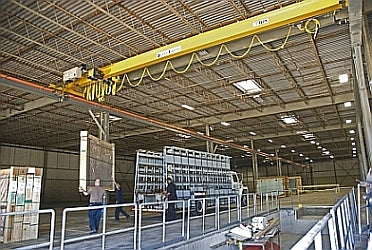
It Is Never Okay to Overload Your Bridge Crane
Andrew T. Litecky
Welcome to The Hoist Guy's Blog, where our resident Hoist Guy, Andrew T. Litecky, shares his knowledge and experience of many years in the overhead material handling industry, this time to share why it’s never OK to overload your bridge crane.
Hazards & Risks of Overloading Your Overhead Lift System
"But they told us we had permission to overload it twice per day. We have it in writing”.
We were amazed to hear our customer thought it was okay to overload their bridge crane. This is a dangerous proposition, and to be clear, it is never okay to overload your bridge crane. By definition, overloading means to lift a heavier weight than the rated capacity of the crane.
Lifting More than Rated Capacity of Crane
The customer in this case was large and busy enough to hire three different vendors, including Shupper-Brickle, to service their hoists and cranes. In one of the customer's buildings, a 10-Ton, 60 foot span, double-girder bridge crane of 1990 vintage had been recently upgraded to 15-tons. However, the customer later realized they wanted to perform a pick of 17 tons, twice per day.
When the end-user asked our competitor if they could perform the 17-Ton pick twice per day they were told that “permission” was granted. They received an explicit approval to lift more than the rated capacity of the crane or overload the crane and trolley hoist by two tons. Unfortunately, this advice disregards all standards and best practices, and it puts the end-user at risk for a very serious accident.
Jeopardizing Lift Systems & Putting Operators in Danger
Be advised that there are no OSHA, ANSI, ASME, CMAA or HMI guidelines allowing overhead lifting systems to be overloaded. On the contrary, these industry groups specifically prohibit lifting more than the rated load on any piece of equipment. Any "permission" to irregularly lift or intentionally overload a bridge crane or hoist seriously jeopardizes the lifting equipment and the operators.
Runway & Bridge Crane Engineering Study
Shupper-Brickle was given an order by the customer to perform an engineering study to examine the design of the runway and bridge. This is the only way to determine the true capacity of an overhead system and proceed safely. To be clear, it is never okay to overload a crane.
If you have any questions about what the actual capacity of your crane or hoist is, contact us. We offer more than 50 years of experience in the crane and hoist industry along with crane engineering services, load testing services and field services such as crane repairs and crane installation. If you are looking for information on overload devices, you can read about them in our blog post: Hoist Overload Devices vs. Thermal Overload Protection.


